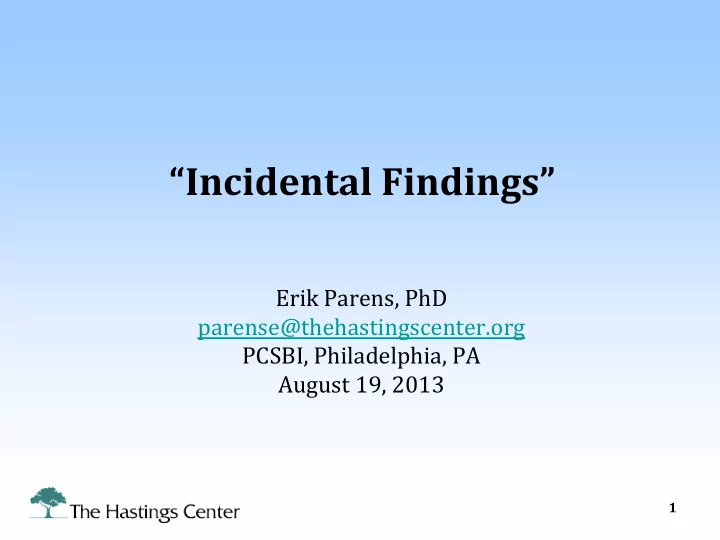

“Incidental Findings” Erik Parens, PhD parense@thehastingscenter.org PCSBI, Philadelphia, PA August 19, 2013 1
Acknowledgements Paul Appelbaum Wendy Chung The ELSI Program – NHGRI grants R21 HG006596, R01 HG006600, and P20 HG005535 2
The Commission’s Question “How can the term incidental findings facilitate or impede consideration of the underlying ethical issue?” 3
The Underlying Issue When research subjects, or patients, or consumers submit all or some part of their bodies for analysis, of all of the information that in principle could be sought and returned, which information should be sought and returned? 4
Creating Useful Genomic Information 1. Gather data: a 3-billion-base pair sequence. 2. Apply a “filter” to look for a gene sequence(s). 3. Validate and interpret that information. As “filters” and “reference databases” improve, and as the amount of effort entailed by validation and interpretation thereby diminish, it will require as little human effort to “test” for 57 genes as to test for 1. 5
Questions Posed by the Technology: 1. Is some information potentially so beneficial that looking for it and returning it should be mandatory? 2. Is some information too expensive to look for and/or return? 3. Is some information potentially so harmful that looking for it should be prohibited? 6
Among the Many Variables Roles and contexts – Research – Clinical care – Prenatal care – Direct-to-consumer Nature of the trait – Disease that can be treated – Disease that can’t be treated – Non-disease trait Strength of the result – How analytically valid is the result? – How much phenotypic variance does the sequence account for? 7
Facilitating Consideration Of the Underlying Issue A reminder to resist genetic exceptionalism. Insofar as a more expansive sense of “incidental” is ever more commonly deployed in the literature, we could think of incidental as a “term of art.” We could just accept that it’s not possible—or that it’s too costly in terms of academic energy—to try to retain the more familiar, “traditional” sense. 8
Impeding Consideration Of the Underlying Issue We might say that it is “terminologically sloppy” to use incidental to refer to findings that are intentionally discovered. As a general matter, terminological sloppiness doesn’t conduce to productive conversation. Terminological sloppiness here can become complicit with our desire to turn away from the underlying ethical issue. 9
4 Types of Findings Primary – target is A, and one finds something relevant to A Incidental – target is A, but one stumbles upon B Secondary – primary target is A, but one looks for B thru F, too General – purpose is to look for A thru Z 10
Bottom Line If we were to continue on our current path, using “incidental” in an increasingly expansive sense, we could conserve some academic energy. My concern, though, is that that energy savings might come at too great an ethical cost: it might come at the cost of open and clear deliberation about what we are —and should be— doing. 11
Recommend
More recommend